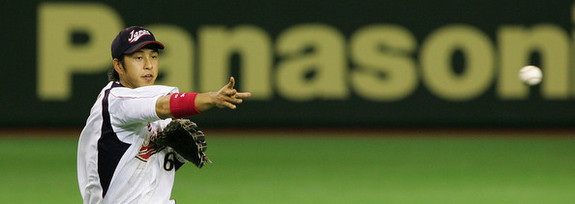
One of the Yankees’ most surprising non-moves last offseason was their pursuit of Japanese shortstop Hiroyuki Nakajima. They won his negotiating rights with a $2.5M bid — team officials gave the impression it was a token “let’s see what happens” bid and were surprised when they won — but failed to reach an agreement on a contract. Back to the Seibu Lions went Nakajima, who hit .311/.382/.451 with 13 homers in 2012, right in line with his career averages.
The 30-year-old Nakajima is a true free agent this winter and is again looking to come over to MLB, and in fact he’s already being courted by the Diamondbacks. The Yankees liked him as a utility man last winter and obviously felt he was worth a $2.5M posting fee, so could they get involved again a year later? We know they’re seeking an upgrade over Jayson Nix, a utility man who can play 100 games between shortstop and third base next season, so if nothing else they should at least check in.
There isn’t much info about Nakajima out there, so we don’t know much about him other than the fact that he’s a right-handed hitter who’s posted decent strikeout (15.0 K%), walk (8.3 BB%), and power (.157 ISO) rates over the last three seasons. He’s played shortstop almost exclusively during his career with the Lions, though he was open to the utility role for New York last year. That’s all I know about Nakajima right there.
In a recent piece on ESPN, Ben Lindbergh spoke to former Dodgers GM Dan Evans — he signed Kaz Ishii prior to 2002 — and Japan Times journalist Jason Coskrey about why some Japanese players (Ichiro Suzuki, Hideki Matsui) are better able to make the transition to MLB than others (Kaz Matsui, Tsuyoshi Nishioka). Here’s a quick recap of the factors they cited…
- Ability to handle an MLB-caliber fastball. This one seems obvious, but it’s often taken for granted. “Leg kicks are prevalent [in Japan], but they can elongate a swing,” said Coskrey. “[MLB hitters] have to deal with pitchers with better stuff pounding the strike zone.”
- Don’t be a starter or middle infielder. Starting pitchers are creatures of habit who have to adjust their routine while infielders have to adjust to a new playing surface. Notice how MLB’s most successful Japanese hitters are outfielders (Ichiro, Matsui) while the infielders (Matsui, Nishioka) have faltered. Evans likened it to “taking a golfer out of Florida and asking him to putt on California’s greens for the first time,” which I can’t relate to at all.
- Good makeup. The Yankees value strong makeup, but it’s important for a Japanese player coming over to MLB because of the adjustments that have to be made. Not just to the higher caliber of competition either, to a new culture off the field as well. Lindbergh notes how this works two ways, as U.S.-born players who go to Japan tend to struggle the first year as they adjust to a new way of life.
We know Nakajima is a middle infielder, but we have no way of knowing how he relates to numbers one and three. For what it’s worth, Coskrey says Nakajima has “the mental makeup to do well. He’s a guy who’s really open to new things, really open to being coached and the type of player I think won’t really have too much trouble adjusting to the lifestyle.” Can he hit a good fastball though? Your guess is as good as mine.
With Marco Scutaro, Stephen Drew, and Jeff Keppinger expected to land starting jobs somewhere, the crop of free agent utility infielders is pretty barren this offseason. There’s Ronny Cedeno, Ryan Theriot … and that’s pretty much it. The difference between those two guys and Nakajima is that we already know they’re terrible big leaguers, but there’s a chance Nakajima might not be. I don’t think that’s enough to hand him a guaranteed contract, especially not with the 2014 payroll plan looming, but the Yankees should at least put a call in to see if he’s open to being an oft-used utility man behind some Hall of Famers who will give him a chance to win right away.
Leave a Reply
You must be logged in to post a comment.